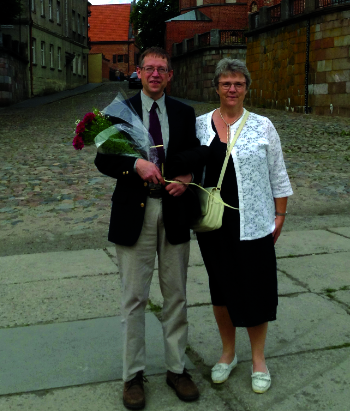Meet the muscle man with a difference
Lucien Tuinstra chats with Professor1 Hans Degens

Dr Hans Degens has an M.Sc. in biology from the Agricultural University Wageningen, the Netherlands, specializing in population, organismal, cell and molecular biology. His Ph.D, in exercise physiology, is from the Catholic University Nijmegen, also in the Netherlands. He has held several postdoctoral positions; at the University of Liverpool (UK), Karolinska Institute in Stockholm (Sweden), University of South Florida in Tampa (USA), and the University of Maastricht (the Netherlands). Currently he lectures at the Manchester Metropolitan University (UK) as Professor of Muscle Physiology. Some of his academic interests include age-related changes in skeletal muscle morphology and function, as well as the effects of hypoxia (not enough oxygen) on muscles. He is married with two adult children.
As an expert in muscle physiology, a branch of myology, much of Prof. Degens’ life has been filled with fascinating research that has taken him and his family to many countries.
Early life and formative years
Hans did not come from a Christian family, although his grandfather was a Jehovah’s Witness.2 At age 14, when his father became a Christian, they went to church together. Asked about how he himself became a Christian, he says:
It was not a dramatic conversion, but rather a conscious awareness that there is more to life than what our physical senses tell us. I realized that the Bible has a clear message that we can only be reconciled with God through the atoning sacrifice and resurrection of Jesus.
Hans has been a committed member of a local church ever since, and continuously seeks to develop his walk with Jesus. He occasionally preaches in his local church.
Besides being a follower of Jesus from a young age, Hans also has interests in model trains, stamps, and reptiles/amphibians (herpetology). Unlike his Christian faith, however, these interests have somewhat receded into the background over the years.
An avid physiological researcher
Prof. Degens has been a prolific writer, with more than 180 papers published in scientific journals, such as the Journal of Anatomy, Journal of Physiology, Muscle & Nerve, and numerous others.3 I was interested to know more about his day-to-day work on the design of our muscular tissue. He said:
Muscle is a remarkable tissue that not only is able to generate force, but it shortens at the same time, both prerequisites for movement. This movement is extremely well controlled, not only by varying the number of muscle cells that are activated for a certain movement, but also by the ability to fine-tune the force that each individual muscle cell develops.
He went on to illuminate this by way of a ‘striking’ analogy:

The extremes of the tuning and muscle cell recruitment to the task at hand are nicely illustrated by the following: the threading of a needle requires fine control, while sledge-hammering a wall for demolition requires much force, but little control. The integration of the neural control of muscle activity occurs without you even thinking about it. This neuromuscular integration, and the subsequent relaxation of muscle ready for the next contraction, is striking. This is something I consider a strong indication of design of the whole system.4

God foresaw the need for us to be able to do rough ‘n’ tough work (including combat post-Fall), as well as gentle and delicate touches (such as caressing a new-born baby). Therefore, He endowed human beings with a wide dynamic range of controlled force; that is the difference between the maximum and minimum muscle forces (over orders of magnitude). It is beyond the capability of today’s engineers to create a robotic arm able to wield a sledgehammer with great force one moment, then exhibit extremely fine dexterity the next, without altering hardware and/or software.5
Connecting faith and research
Since Hans seems to have thrived as a creationist in the world of academia, I asked whether it had always been easy to live out his faith in the workplace? He acknowledged that it had not always been easy, and shared how he got caught up in a debate in his home country. Evolution had actually been removed from the requirements for secondary school examinations in the Netherlands for a time. There was a push by the Dutch Society of Biologists to get evolution reintroduced into the exams after 1993. Prof. Degens said:
In response, I wrote a letter saying that was really an unnecessary approach.6 For that, I was soundly ostracized and received a lot of ad hominem (personal) attacks, rather than comments dealing with the topic on hand.
Two years later, the controversial decision to remove evolution was reversed and it was, not surprisingly, put back into the Dutch school examinations.
I asked Hans about positive impacts and fruit from his Christian faith at work, particularly his commitment to creation? He replied:
My work is about how the body works (operational science). I quite often use the terminology “looks like design” in my lectures on muscle physiology. This is obvious from my worldview, and for the increasing number of Muslims attending, it makes sense from their perspective also. Some students realized what I was implying, and wanted to discuss this further. When I learned they were really serious, I invited them to stay behind afterwards to discuss the issue of origins outside of lecture hours.
A creative thinker

Aside from Prof. Degens’ substantial contributions to the understanding of human physiology, he actively and enthusiastically engages in creationist thinking and writing.7 Hans says that a discussion of physiology also involves ageing, a topic which he has researched and written about.8 I asked him if ageing is better explained in light of the biblical Fall?
The fascinating thing is that organisms seem to be built for survival and not death. A common observation is that if organisms live in a safe environment, for instance without predators, the average life span increases dramatically, albeit at the expense of reproduction. This led to the rather speculative thesis of my CRSQ paper that if the environment is so safe that no accidental death can occur, and damage to cells from things like cosmic radiation and pollutants is limited, we may live eternally.
The words ‘live eternally’ sparked my interest. Hans pointed out that DNA repair genes are abundant, and there might also be other cellular pathways that, because of the Curse (Genesis 3), no longer work perfectly. Indeed, it is fascinating to consider what might be possible if all of these were functioning perfectly. Hans continued:
Such would only be present in a situation like Paradise, because no matter how safe we make our environment in this present world we still will have a chance of dying from an accident. This is part of what occurred at the Fall, where the risk of accidental death increased enormously. But the environment also became less friendly, inducing a higher rate of damage to our cells than our ability to repair it. This is all speculative of course, and can never be proven. And there is evidence that a lot of ageing is genetically determined. But the notion that life without ageing (in other words, without accidents and disease, ‘eternal’ life) is in essence possible, even in our current world, is reflected by organisms that indeed show no evidence of ageing. And, so far, they appear to live eternally. This is something I have written about in a creation science journal.8
Certainly, the possibility of halting ageing and achieving biological ‘immortality’ is intriguing. There are examples of ‘eternally living animals’ in the natural world; that is, they have not been genetically altered. And it’s not just single cells. There are apparently seven species known to science that appear not to age at all.9
Of course, we know that despite now living in a fallen universe with bodies that deteriorate, believers will get new bodies (2 Corinthians 5:1–5) in the New Heavens and New Earth (e.g. Revelation 21:1).
Final comments
My hope is that the accomplishments of Prof. Degens (and many others like him) might encourage young Christian students to pursue a career in science. After all, here is a Bible-believing Christian who is successful in scientific research and lecturing at a secular university. His advice to them:
When starting a scientific career in the area of biology be sure that you know at least the basics of the theory of evolution, read works by secular scientists that have reservations about the neo-Darwinian theory of evolution, and read Intelligent Design and creationist literature. This is crucial to counter the apparently convincing arguments for the theory of evolution and promote the concept of creation and design.
It was good to have met yet another ally in upholding the truth and authority of God’s Word.
References and notes
- In the British system, this indicates the highest academic rank of university teacher. Return to text.
- Cf. Cosner, L., Knock, knock … are you ready? Creation 40(3):44–46, 2018. Return to text.
- For a list of his published articles, see creation.com/degens. Return to text.
- See Catchpoole, D., Fingertip control, Creation 31(2):31, 2009. Return to text.
- See Catchpoole, D., The Potter’s Hands, Creation38(1):56, January 2016. Return to text.
- See: trouw.nl/nieuws/evolutie-en-eindexamen-1~b749ed5c/ (in Dutch). Return to text.
- A paper he coauthored in a secular journal showed in a model that mutation protection prevents macro evolution. The article was chosen by ICR that year as one of the top 10 secular articles supporting creation. DeJong, W. and Degens, H., The Evolutionary dynamics of digital and nucleotide codes: A mutation protection perspective, Open Evolution J. 5:1–4, 2011. Return to text.
- Degens, H., The origin of senescence and death: An evolutionary enigma, CRSQ 44(4):279–285, 2008. Return to text.
- Species with negligible senescence, AnAge: The Animal Ageing and Longevity Database, genomics.senescence.info; accessed 17 Dec 2019. Return to text.




Readers’ comments
Comments are automatically closed 14 days after publication.